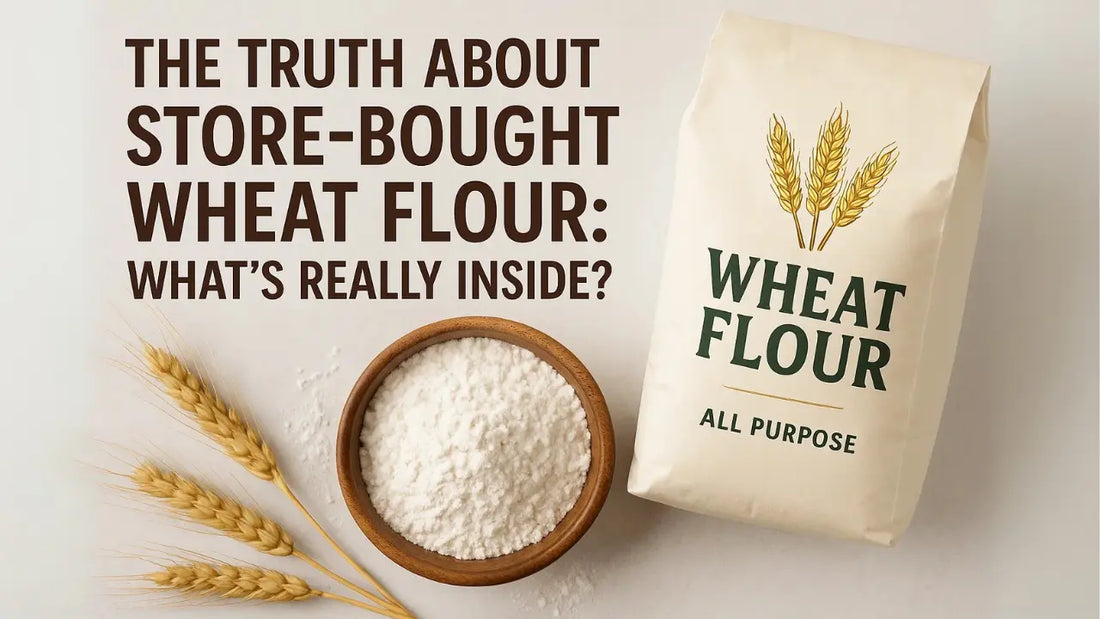
The Truth About Store-Bought Wheat Flour: What’s Really Inside?
MOORAV FOODTECH PRIVATE LIMITED AdminShare
Wheat flour is a staple in almost every kitchen. From chapatis and breads to biscuits and cakes, it forms the base of many everyday foods. But have you ever thought about what actually goes into the wheat flour you buy from the supermarket?
Many people assume all wheat flour is the same. The truth is, there can be a big difference between freshly milled, wholesome flour and the mass-produced kind that sits on store shelves for months. Understanding this difference can help you make better choices for your health and your family!
Table of Contents
-
What Is Wheat Flour Made From?
-
What Really Happens to Store-Bought Wheat Flour
-
Why Fresh, Natural Wheat Flour Is Better
-
How to Choose the Right Wheat Flour
-
The 10on10 Foods Difference
- Frequently Asked Questions
What Is Wheat Flour Made From?
Wheat flour comes from grinding whole wheat grains. These grains have three main parts: the bran, the germ, and the endosperm.
- Bran – The outer layer, rich in fibre, minerals and antioxidants.
- Germ – The nutrient-rich core containing vitamins, minerals and healthy fats.
- Endosperm – The inner part that is mostly starch and protein.
In its natural state, wheat flour contains all three parts. This is called whole wheat flour and is full of nutrients and fibre. But most commercial wheat flour is refined, which means the bran and germ are removed during processing.
What Really Happens to Store-Bought Wheat Flour
Commercially produced wheat flour goes through several steps before it reaches the store shelf. While this makes it last longer and look whiter, it also reduces its nutritional value.
Refining and Bleaching
Most store-bought wheat flour is refined to remove the bran and germ. This process makes it smoother and easier to bake with, but it strips away much of the fibre, vitamins and minerals. Some brands then bleach the flour to make it look even whiter.
Adding Preservatives
To keep flour from spoiling during storage and transport, preservatives may be added. While these extend shelf life, they do nothing for your health.
Fortification
Because refining removes so many nutrients, manufacturers often add some back artificially, such as iron or certain B vitamins. However, this is not the same as having them in their natural form.
Long Storage Times
Store-bought wheat flour can sit in warehouses and shops for months. Over time, even the small amount of natural nutrients left can degrade.
Why Fresh, Natural Wheat Flour Is Better
When wheat flour is freshly milled and minimally processed, it keeps more of its natural goodness. You get the full benefit of fibre, vitamins, minerals and healthy fats. This can mean:
-
Better digestion due to higher fibre content.
-
More sustained energy from complex carbohydrates.
-
Richer flavour and aroma in your cooking and baking.
-
Fewer chemicals and additives in your diet.
Fresh wheat flour also has a more natural colour and texture. Your chapatis and breads may look slightly darker, but they will taste better and be more satisfying.
How to Choose the Right Wheat Flour
If you want the healthiest option for your family, here are a few tips:
- Check the ingredients – Look for 100% whole wheat flour with no added chemicals.
- Look for small-batch or stone-ground options – These tend to be less processed.
- Check the packaging date – Fresher is always better.
-
Buy from trusted brands – Choose companies that focus on quality over mass production.
The 10on10 Foods Difference
At 10on10 Foods, we believe flour should be as natural as possible. Our wheat flour is made from premium grains sourced from trusted farmers. It is milled carefully to preserve nutrients, flavour and freshness.
We never add unnecessary chemicals or bleach. Every pack is produced in small batches, so you always get fresh, wholesome flour for your home.
Order your 10on10 Foods Wheat Flour today and taste the real difference in every bite.
Frequently Asked Questions
Q1. Is whole wheat flour healthier than white flour?
A1. Yes. Whole wheat flour contains all parts of the grain, which means more fibre, vitamins and minerals compared to refined white flour.
Q2. How should I store wheat flour at home?
A2. Keep it in an airtight container in a cool, dry place. For longer freshness, you can refrigerate or freeze it.
Q3. Why does fresh wheat flour look darker?
A3. The natural bran and germ in whole wheat flour give it a slightly darker colour. This is a sign that it is less processed and more nutritious.
Q4. Can I use whole wheat flour for all recipes?
A4. Yes. It works for chapatis, breads, cakes and biscuits. You may need to adjust liquid amounts slightly because of the extra fibre.

